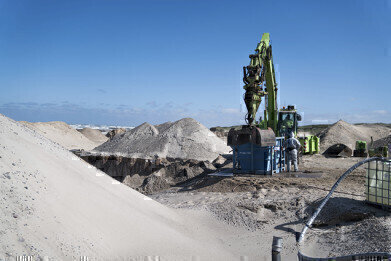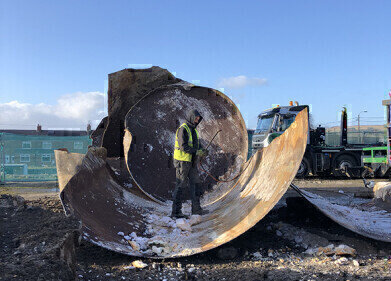Soil Remediation
Large-scale tests of sand treatment plant at Danish landfill show convincing results
May 29 2020
Fortum Recycling & Waste has tested the effect of the technology for cleaning of the heavily polluted sand at Groyne 42 landfill in Western Denmark. The results are convincing. In the pilot test, 90 tonnes of sand is cleansed of mercury and pesticides to a level where the majority can be used freely and the rest for construction purposes. It makes it possible to remove the historical pollution.
After a longer test run, it is now clear that the technology developed by Fortum Recycling & Waste to clean the sand at Groyne 42 is as effective as hoped. The now completed pilot test shows that the technology can remove 99.5 percent of the pollution in the sand.
In practice, this means that most of the sand meets the Danish Environmental Protection Agency's criteria for clean soil* and can therefore be used freely, while the rest is clean enough to be used for construction purposes - for example substrates for roads.
“Up to 80 percent of the contaminated sand can be cleansed by treating it once in the new plant. The remaining 20 percent must be treated twice, and thereafter it will meet the criteria in relation to both mercury and pesticides, so that it can be utilized for construction purposes. It is compelling and in line with what we had hoped and expected,” says R&D manager PhD Thomas von Kronhelm from Fortum Recycling & Waste.
The technology, commonly called MOPS (short for Multi-purpose Onsite Phase Separator), can roughly be termed as a large industrial washing machine with various steps. In the core of the process, the high-pressure sand is rinsed with a special liquid that separates the contaminated substances in a sludge phase. The process water is reused in the treatment. The sludge is transported to Fortum in Nyborg and treated by high temperature incineration. Then the sand is cleansed.
“We develop sustainable solutions that protect and recycle the resources of the nature. The MOPS technology has great potential both locally and globally, because many soil pollutants call for this type of purification process, and furthermore it is efficient and local,” says Kalle Saarimaa, Vice President at Fortum Recycling and Waste.
In March, the Regions in Denmark submitted a comprehensive plan for prioritizing, costing and cleansing the Danish generational pollutions to Environment Minister Lea Wermelin. Groyne 42 at Harboøre Tange, which for decades has been an unsolved environmental problem, is one of the pollutions that has been investigated and ready for clean-up.
Chairman of the Committee for Regional Development in Central Jutland Jørgen Nørby (The Liberal Party) welcomes the news from Fortum: “It is very positive that another Danish solution is now in play for the purification of our generational pollution, and we look forward to studying the results. At Harboøre Tange in Western Jutland, we have three major generational pollutions - the chemical depot at Groyne 42 and the chemical company Cheminova's old factory site are the two sites ready to be cleaned up. We still wait for the Parliament to prioritize the funding so that we can get started”.
The United Nations Food and Agriculture Organization (FAO) has also shown interest in the MOPS technology, which holds international perspectives on sustainable solutions to environmental challenges and resource recycling.
Events
IWA World Water Congress & Exhibition
Aug 11 2024 Toronto, Canada
Aug 25 2024 Stockholm, Sweden and online
Sep 03 2024 Mexico City, Mexico
Sep 03 2024 Mexico City, Mexico
Sep 03 2024 San Diego, CA, USA













